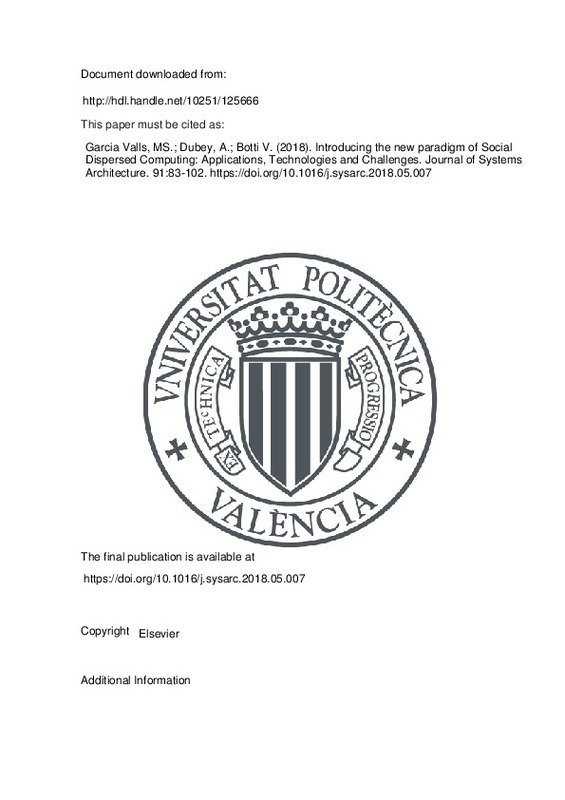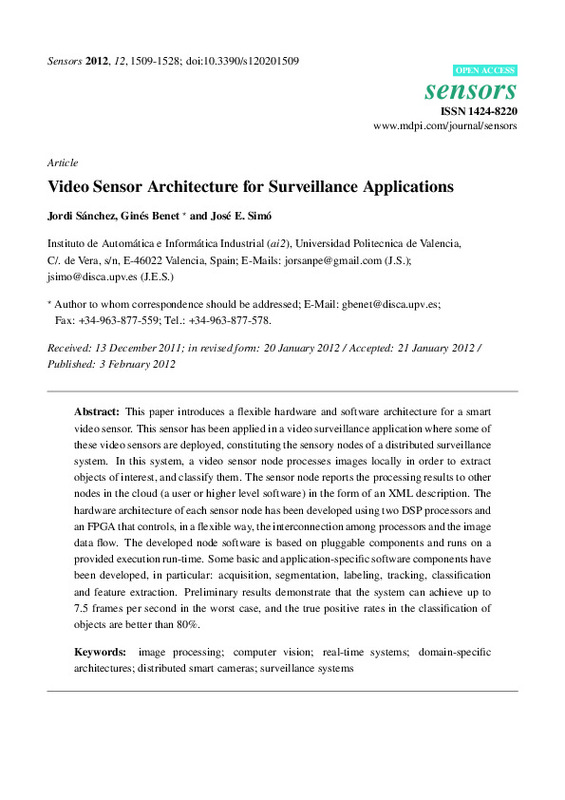JavaScript is disabled for your browser. Some features of this site may not work without it.
Buscar en RiuNet
Listar
Mi cuenta
Estadísticas
Ayuda RiuNet
Admin. UPV
Introducing the new paradigm of Social Dispersed Computing: Applications, Technologies and Challenges
Mostrar el registro sencillo del ítem
Ficheros en el ítem
| dc.contributor.author | Garcia Valls, Maria Soledad
|
es_ES |
| dc.contributor.author | Dubey, Abhishek
|
es_ES |
| dc.contributor.author | Botti, V.
|
es_ES |
| dc.date.accessioned | 2019-09-13T20:01:55Z | |
| dc.date.available | 2019-09-13T20:01:55Z | |
| dc.date.issued | 2018 | es_ES |
| dc.identifier.issn | 1383-7621 | es_ES |
| dc.identifier.uri | http://hdl.handle.net/10251/125666 | |
| dc.description.abstract | [EN] If last decade viewed computational services as a utility then surely this decade has transformed computation into a commodity. Computation is now progressively integrated into the physical networks in a seamless way that enables cyber-physical systems (CPS) and the Internet of Things (IoT) meet their latency requirements. Similar to the concept of ¿platform as a service¿ or ¿software as a service¿, both cloudlets and fog computing have found their own use cases. Edge devices (that we call end or user devices for disambiguation) play the role of personal computers, dedicated to a user and to a set of correlated applications. In this new scenario, the boundaries between the network node, the sensor, and the actuator are blurring, driven primarily by the computation power of IoT nodes like single board computers and the smartphones. The bigger data generated in this type of networks needs clever, scalable, and possibly decentralized computing solutions that can scale independently as required. Any node can be seen as part of a graph, with the capacity to serve as a computing or network router node, or both. Complex applications can possibly be distributed over this graph or network of nodes to improve the overall performance like the amount of data processed over time. In this paper, we identify this new computing paradigm that we call Social Dispersed Computing, analyzing key themes in it that includes a new outlook on its relation to agent based applications. We architect this new paradigm by providing supportive application examples that include next generation electrical energy distribution networks, next generation mobility services for transportation, and applications for distributed analysis and identification of non-recurring traffic congestion in cities. The paper analyzes the existing computing paradigms (e.g., cloud, fog, edge, mobile edge, social, etc.), solving the ambiguity of their definitions; and analyzes and discusses the relevant foundational software technologies, the remaining challenges, and research opportunities. | es_ES |
| dc.language | Inglés | es_ES |
| dc.publisher | Elsevier | es_ES |
| dc.relation.ispartof | Journal of Systems Architecture | es_ES |
| dc.rights | Reserva de todos los derechos | es_ES |
| dc.subject | Social dispersed computing | es_ES |
| dc.subject | IoT | es_ES |
| dc.subject | Fog Computing | es_ES |
| dc.subject | Cloud Computing | es_ES |
| dc.subject | Dispersed Computing | es_ES |
| dc.subject | Social Computing | es_ES |
| dc.subject | Edge Computing | es_ES |
| dc.subject | Distributed computing | es_ES |
| dc.subject | Cyber physical systems | es_ES |
| dc.subject | Real time | es_ES |
| dc.subject | Middleware | es_ES |
| dc.subject | Virtualization | es_ES |
| dc.subject | Containers | es_ES |
| dc.subject | Microservices | es_ES |
| dc.subject | Distributed transactions | es_ES |
| dc.subject | Blockchain | es_ES |
| dc.subject | Multi agent systems | es_ES |
| dc.subject | Distributed coordination | es_ES |
| dc.subject | Complex event processing | es_ES |
| dc.subject | Networking | es_ES |
| dc.subject.classification | INGENIERIA TELEMATICA | es_ES |
| dc.subject.classification | LENGUAJES Y SISTEMAS INFORMATICOS | es_ES |
| dc.title | Introducing the new paradigm of Social Dispersed Computing: Applications, Technologies and Challenges | es_ES |
| dc.type | Artículo | es_ES |
| dc.identifier.doi | 10.1016/j.sysarc.2018.05.007 | es_ES |
| dc.relation.projectID | info:eu-repo/grantAgreement/GVA//PROMETEO%2F2018%2F002/ES/TECNOLOGIES PER ORGANITZACIONS HUMANES EMOCIONALS/ | es_ES |
| dc.rights.accessRights | Abierto | es_ES |
| dc.contributor.affiliation | Universitat Politècnica de València. Departamento de Sistemas Informáticos y Computación - Departament de Sistemes Informàtics i Computació | es_ES |
| dc.contributor.affiliation | Universitat Politècnica de València. Departamento de Comunicaciones - Departament de Comunicacions | es_ES |
| dc.description.bibliographicCitation | Garcia Valls, MS.; Dubey, A.; Botti, V. (2018). Introducing the new paradigm of Social Dispersed Computing: Applications, Technologies and Challenges. Journal of Systems Architecture. 91:83-102. https://doi.org/10.1016/j.sysarc.2018.05.007 | es_ES |
| dc.description.accrualMethod | S | es_ES |
| dc.relation.publisherversion | https://doi.org/10.1016/j.sysarc.2018.05.007 | es_ES |
| dc.description.upvformatpinicio | 83 | es_ES |
| dc.description.upvformatpfin | 102 | es_ES |
| dc.type.version | info:eu-repo/semantics/publishedVersion | es_ES |
| dc.description.volume | 91 | es_ES |
| dc.relation.pasarela | S\370042 | es_ES |
| dc.contributor.funder | Generalitat Valenciana | es_ES |







![[Cerrado]](/themes/UPV/images/candado.png)



